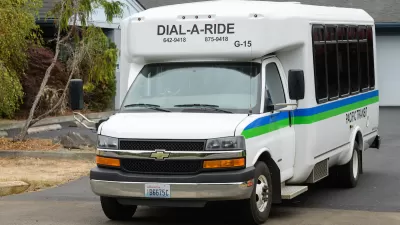Minnesota’s on-demand microtransit service is helping connect residents to fixed-route service and daily needs.

Some transit services that are including on-demand services are seeing bigger increases in ridership, according to an article in the Minnesota Reformer, as post-pandemic travel patterns shift away from the typical 9-to-5 commutes.
In Minnesota, the Minnesota Valley Transit’s Connect service “is so popular that it’s having trouble keeping up with demand, even as the Legislature allocated over $9 million last year to build out Connect and similar systems statewide.”
Unlike other dial-a-ride services, Connect and other microtransit options offer service within an hour or less. It also lets passengers board without a reservation when the bus stops to pick up someone else.
Microtransit options can work well in less-dense areas and suburbs where few other transit options are available and where ridership is sparse. However, the per-mile cost of these services can be prohibitive to some agencies and, some have argued, does not scale well. For example, “To manage demand, MVTA only allows riders to book rides up to three hours ahead of time, while also cutting some regular bus service in September to ensure they have enough drivers to provide the service in their existing areas.”
FULL STORY: Local transit agencies mimicking Uber and Lyft are seeing big ridership gains

Planetizen Federal Action Tracker
A weekly monitor of how Trump’s orders and actions are impacting planners and planning in America.

Map: Where Senate Republicans Want to Sell Your Public Lands
For public land advocates, the Senate Republicans’ proposal to sell millions of acres of public land in the West is “the biggest fight of their careers.”

Restaurant Patios Were a Pandemic Win — Why Were They so Hard to Keep?
Social distancing requirements and changes in travel patterns prompted cities to pilot new uses for street and sidewalk space. Then it got complicated.

Maui's Vacation Rental Debate Turns Ugly
Verbal attacks, misinformation campaigns and fistfights plague a high-stakes debate to convert thousands of vacation rentals into long-term housing.

San Francisco Suspends Traffic Calming Amidst Record Deaths
Citing “a challenging fiscal landscape,” the city will cease the program on the heels of 42 traffic deaths, including 24 pedestrians.

California Homeless Arrests, Citations Spike After Ruling
An investigation reveals that anti-homeless actions increased up to 500% after Grants Pass v. Johnson — even in cities claiming no policy change.
Urban Design for Planners 1: Software Tools
This six-course series explores essential urban design concepts using open source software and equips planners with the tools they need to participate fully in the urban design process.
Planning for Universal Design
Learn the tools for implementing Universal Design in planning regulations.
Heyer Gruel & Associates PA
JM Goldson LLC
Custer County Colorado
City of Camden Redevelopment Agency
City of Astoria
Transportation Research & Education Center (TREC) at Portland State University
Camden Redevelopment Agency
City of Claremont
Municipality of Princeton (NJ)





























